The Swimrun: A New Experience
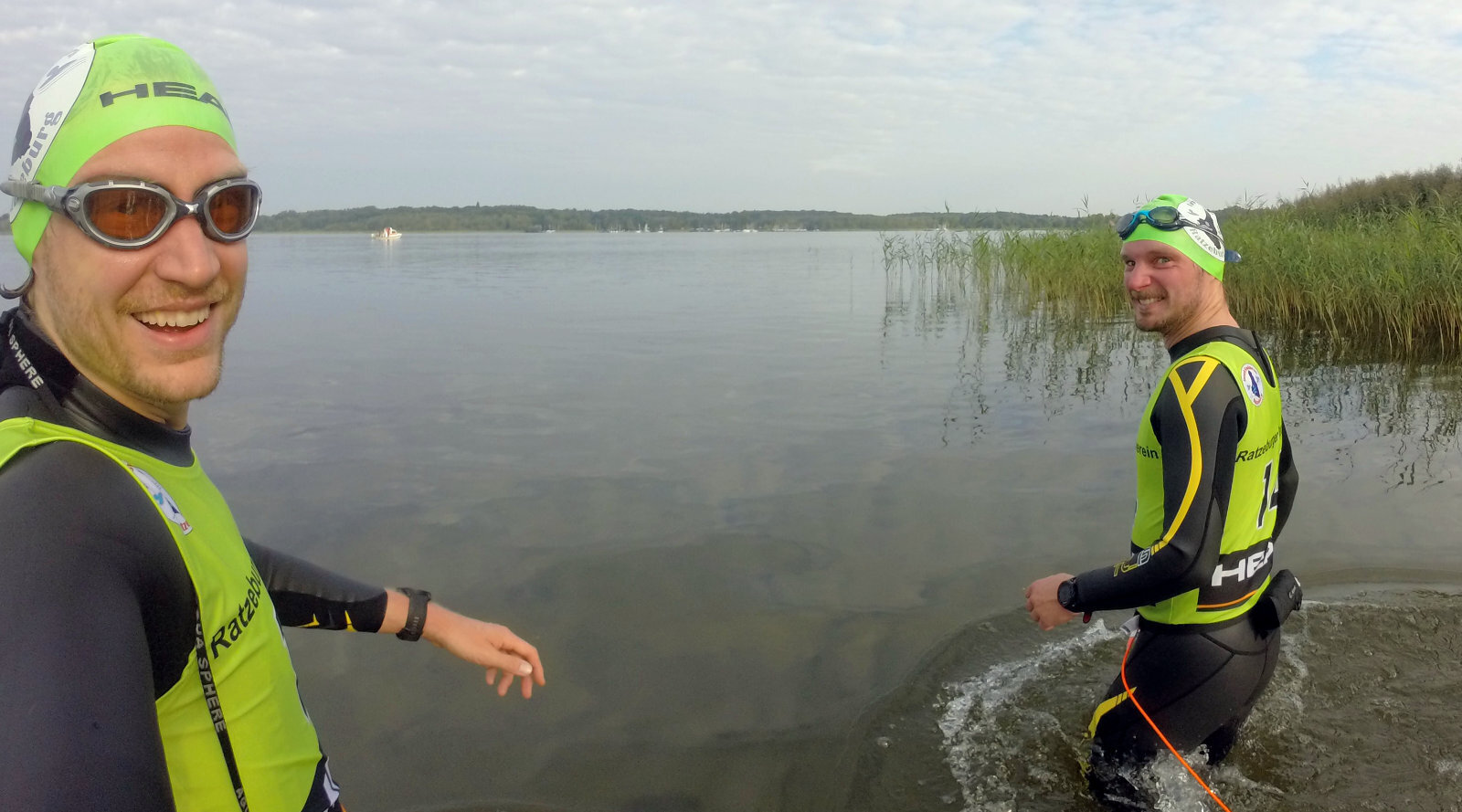
Just ‘a Triathlon Without the Biking’? Far From it!
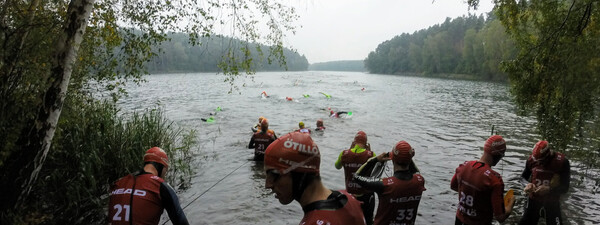
From the category: I tried it so you don’t have to!
What do you do when you feel you’ve done enough marathons, triathlons, and even ultramarathons for a year? Try something new, of course!
A few years back I’ve heard about this crazy new thing from Sweden. Recently it has come up more and more in conversations with athlete friends or just in my online bubble. Intrigued, I researched and found it to be a very interesting format worth trying out.
This story is a three-parter:
- But What’s a Swimrun? – An Introduction
- 1. Ratzeburger Insel Swimrun – The Test Run
- ÖtillÖ 1000 Lakes – The Original
But What’s a Swimrun?
Quite obviously, there’s some swimming and some running involved. Other than the lack of biking, it has some serious differences from a triathlon as well. A Swimrun has a kind of survivalist touch to it. It’s a little adventure.
- It’s usually an A to B course, meaning you start far away from the finish.
- It’s not a single swim segment followed by a single run segment, but rather lots of runs which are broken apart by lots of swims.
- There is no transition zone. You have to bring all your needed equipment along for the whole race.
- You don’t race alone, but in teams of two. Teams can be male, female, or mixed. There is supposed to be a rope between you two, for safety reasons during the swims especially.
- This means that you will have to swim with your running shoes on and also run while wearing your neoprene wetsuit.
That’s the basic rules. Quite unusual, but not too difficult. The only part that gave me a tiny headache was the last one. What would it be like to swim with running shoes and run with a wetsuit?
First, a Brief History of the Swimrun
This sport hasn’t been around for a long time. It started off quite recently, when four Swedish buddies were thinking of a new athletic bet to compete with each other. That happened in 2002.
They set a rough course from the village of Utö to the village of Sandhamn. Both places are on islands not too far from Stockholm, Sweden. The distance of about 50 kilometers – as the crow flies – shall be covered without any machines or helpful devices, only by swimming and running. Coining the term ÖtillÖ, Swedish for „Island to island“.
This bet looked like the following. They would divide the teams into two teams of two, and the first team to reach each of three agreed-upon restaurants on the way to the pub at the finish line would get to order food for the second team, which those then had to eat and pay for when they reached the places. Hope those restaurants don’t serve disgusting specialties!
The race went down as planned, but the finish line party had to be postponed because both teams were just exhausted beyond all they had ever experienced during the 24 hours of racing for about 65 kilometers on foot and 10 kilometers in the water. And those were some strong Swedes we’re talking about here!
Needless to say, it had to be repeated to improve the results and find ways to assure there would be enough energy left for a big party at the end.
Four years later, in 2006, two friends of the initial group of four, named Michael Lemmel and Mats Skott, made this race into a professional event. Starting then, it grew internationally. As with all endurance events, the popularity has not yet reached its full potential and we can expect to see more races popping up everywhere, getting bigger and bigger.
How Do We Get Started?
ÖtillÖ is now a brand, a bit like Ironman, just not as capitalistically greedy, but rather preserving its Swedish charm. The similarity being, there are five races in Europe branded as official ÖtillÖ races, in which you can participate and hope to be fast enough to secure a spot at the annual World Championships in its birthplace, the Swedish archipelago in Stockholm’s vicinity.
Germany got its first ÖtillÖ race in 2016, but it was not on my horizon to participate at that inaugural event. I followed it and thought it to be very cool, so I decided to be part of it in 2017. I found a crazy and strong endurance racer to do this insane race with me. His name is Rasmus and he used to be an exceptional water polo player as well as a 3:07 hour marathon runner. The guy knows how to swim and run. I’m not as fast, but I hoped he could pull me through.
We signed up. The event here in Germany is called ÖtillÖ 1000 Lakes because it takes place in the Mecklenburgische Seenplatte, an area in Germany containing, – you’ve guessed it –, lots of lakes. It’s supposed to happen on October 1st, 2017, and consist of 11 runs of 34 kilometers in total, and 10 swims of 7.5 kilometers in total.
How Do We Prepare?
Just by trying it, as always. I was sitting at a friend’s kid’s birthday party when I talked to one of the other dads, Mischa, about sports. He had studied sports at university and we’ve been running together a few times. He knows how to swim. And I had read about a shorter Swimrun race in the nearby town of Ratzeburg, just two weeks before the big German ÖtillÖ 1000 Lakes. I made the connection and asked him to join my two-person team. He did, and we went.
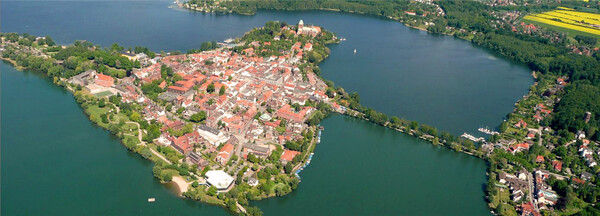
First Ever Ratzeburger Insel Swimrun – The Test Run
The first ever edition of this tiny competition checked all the boxes.
- Shorter than the big ÖtillÖ
- Perfect timing two weeks before ÖtillÖ
- Not too far away
- Not too big
- Not too expensive
I had spend that weekend with my wife Sophie and our three daughters, as well as my sister Nicola and her husband Philipp at a cozy vacation home an hour south of Hamburg. Family getaway! So on Sunday of the race I had to get up quite early, at 4 AM, to make the two hour drive up north to Ratzeburg, a town which is partly surrounded by a lake.
A bucket of coffee and two fritz! kolas had just enough caffeine to get me going. I walked over to the area where it was all supposed to go down, but was surprised that no one seemed to be there. Just one other athlete confirmed that I came to the right place.
A Sigh of Relief
Right then I saw a person who was probably the organizer setting up some sponsored beach flags for a finish line.
“Is this the Ratzeburger Swimrun area?”
“Correct!”
“How many people will participate?” I asked politely but curiously.
“About 20 teams have signed up.”
So that’s just 40 people in total. Tiny competition! This will be fun, I’m sure. But I wondered a bit about the navigational aspect. The tiny races usually have poor signage, and following others wouldn’t be easy when just 20 teams were going to be on this long course.
As the time went on, my friend Mischa arrived with his son, sister and brother-in-law, as well as a few dozen others keen to swim and run.
Mischa and I got our bib vests with our team number on it, #14, had to deposit 50 bucks each to get so called Restubes for both of us. Those are safety devices you put around your waist and pull a cord in an emergency in the water to make you float and be more visible to the guards.
The Outfit
One of the biggest questions of this type of race is, what do you wear? It all has to be practical and fulfill a certain purpose. You don’t want to take any excess stuff with you. So here’s what I wore:
- Arena standard Speedo
- My old Aquasphere neoprene wetsuit, of which I cut off the legs right above the knees in order to be able to move more freely
- Long compression socks from my favorite Swedish brand Gococo
- My old and trusty Asics GT-2000 4 running shoes, 2.500 kilometers in them, with a flex-cord to secure them tightly
- The mandatory green bib number vest
- The mandatory green swim cap
- The mandatory Restube around my waist
- My old Aquasphere goggles – good model, fogs the least of all
- A bit of Olive oil in my ears to make the water flow out more easily (great and cheap trick my doctor told me, I would even go as far as to consider it a “Life Hack”)
- Three HoneyPowers underneath my left leg’s neoprene
- A GoPro in a waterproof case underneath my right leg’s neoprene
- Three meters of flexible rope (also called “tether”) tied to my Restube band as well as Mischa’s Restube band
That’s it already. Mischa had nearly the same setup, but he had a rather new wetsuit and didn’t want to cut off the legs.
What Else Could I Have Brought?
The rules are not very tight on this. Allowed is the following:
- Paddles for your hands to increase pressure and swim speed. We opted against it because to us it seemed that this would also require more arm power and therefore tire us out earlier. Also, carrying those things during the runs seemed overkill. Lots of other took those, though. There must be something to it.
- A Pullbuoy, which is a piece of hard foam which you can put between your upper legs during the swim to make them float better. Also, you’d have to carry it during the runs. Many others had it.
- A neoprene cap and neoprene gloves. I bought a cap and brought it with me, but decided against using it. The water seemed not too cold today.
- Swim fins which are no longer than 15cm are also allowed. Of course you’d have to carry them during the run and probably change into/out of them at each transition. I don’t think that it would have been an advantage.
- Floatation help of any kind that is no bigger than 100cm x 60cm. Same thing – what kind of thing could you take with you that would improve your swim so much that it would be able to justify its load during the run? Seriously, this is our chance to get creative!
What Is Usually Recommended on Longer Swimruns?
- A waterproof first-aid kit is usually mandatory, but not this time
- Also, for safety reasons, each one usually has to carry a whistle to blow in a case of emergency. It has to be attached to your wetsuit in an easily reachably way.
- A compass along with a waterproof case for the course map
Mischa and I had everything necessary to complete the course with us, so we could give it a try today. At 8:00 AM there was a short count-down and the race suddenly started. All nearly 40 athletes ran off, all looking the same: dark wetsuit, green bib vest. The only difference was in the color of the swim caps, depending on whether you’re in an all male, all female, or a mixed team.
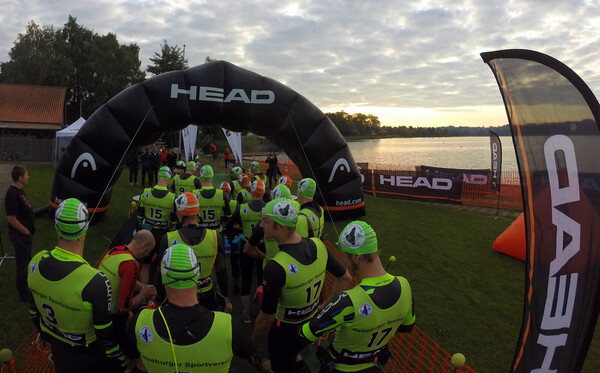
The Race
First off, this was lots of fun! We started with a 550 meter run to warm up, the whole group together, until we reached a little beach and just walked into the cold water in our gear.
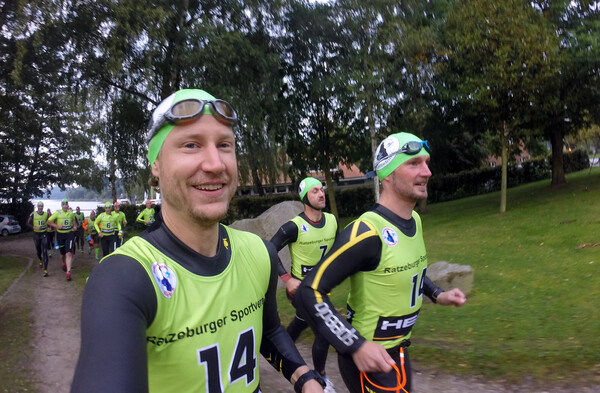
Prepared For Everything!
This feels like an adventure which you begin fully prepared. Whatever nature throws in front of you, you feel like you can handle it. There’s a lake? Swim through, no problem. There’s a hill? Run over it, just the same. This gave me a sensation of freedom I haven’t had before.
Sure, start and finish are fixed, as well as the whole course, but it’s still quite cool to be able to just go with the flow of nature somehow. All the markings and safety boats might as well have been absent. Mischa and I could have gone completely rogue and explore the world that day, wearing our gear. Great feeling!
The first swim was still rather cold for Mischa. He didn’t do any open-water swimming before, as opposed to me. I was expecting to have a cold head for a few minutes, but it’s not pleasant for someone who isn’t used to this. So we were a bit more careful, Mischa did some breaststrokes in the stream of water behind me, and we had to stop so Mischa could tie his loose shoes in the water while I had to hold him up. That’s exactly as difficult as you might think.
By the time he was done, all other teams except for one were in front of us.
Who Cares?!
Not us, to be sure. Our top priority goal today is to finish the race. Sure, not ending up in last place would be nice, but that’s priority number two, if even.
The rest of these 950 meters of swimming were doable. Mischa kept swimming right behind me to save energy and get accustomed to the conditions, mainly to the cold water. I myself wasn’t in top shape regarding the swims. I hadn’t really practiced swimming in the weeks before, so I just swam a bit slower and more conservatively.
The water was great, though. Clear and quite clean as well. Seems like the people living here are taking good care of it!
At the other side of the lake we could see a big red buoy which clearly wasn’t usually located at that spot. So that’s probably where we need to go. At a small race like this, where you’re not surrounded by other participants at all times, finding the correct way can be a real challenge.

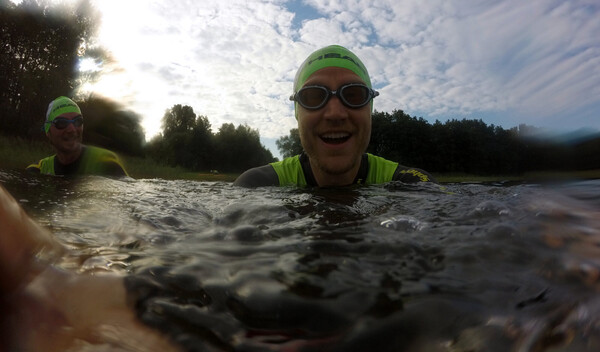
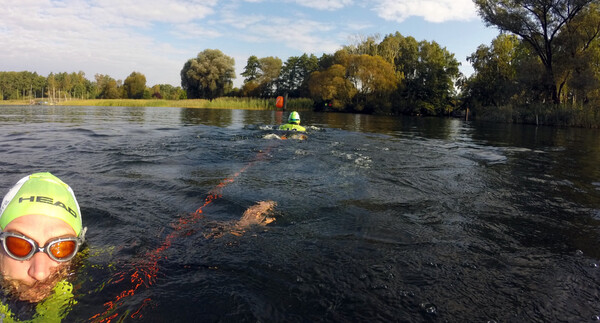
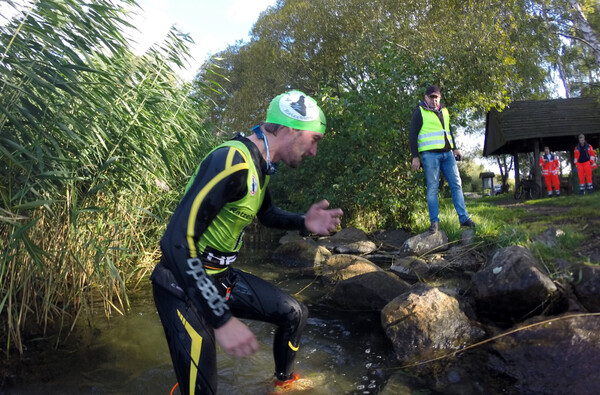
The Volunteers
At almost every exit from a swim, there were a few nice volunteers with a few cheerful words for us. They were writing down our number and time and wished us good look.
Running With Wet Shoes
Eight kilometers of running now. At first, the feet squished in those wet running shoes, sure. But I must say, it’s far less uncomfortable than you might think. After maybe a kilometer, the problem isn’t noticeable anymore. The course was a trail through a forest, mostly in the vicinity of the lake. Very nice and quiet. We passed by some of the teams along this segment.
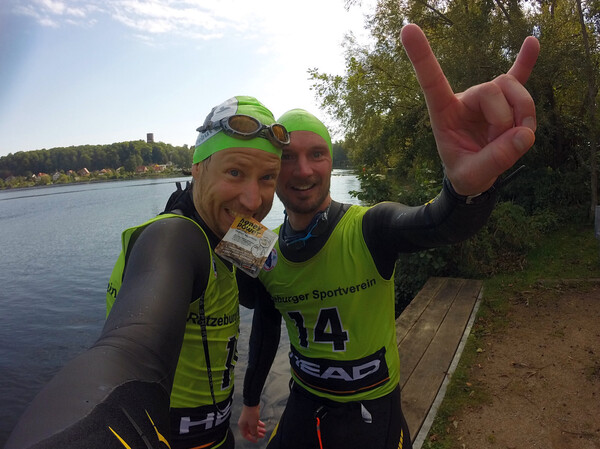
On the whole course there were four or five little aid stations with salty crackers, bananas, and some drinks, too. We chatted a little with the friendly volunteers.
It got warmer as the morning progressed. The fun thing is, as every segment progresses, you really start to look forward to the next one. As a run gets longer, you long for a cold swim to cool down. After some swimming, you wish for the upcoming run to begin in order to warm up.
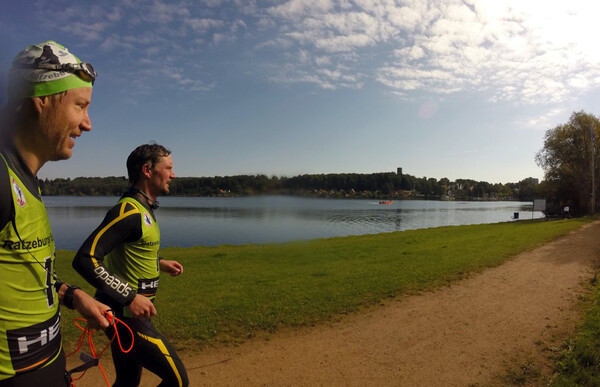
This way it never got boring. All the entrances and exits were different. Very natural, but usually easy to manage. The water kept being clean and clear, the weather improved even more. So we made our way through the 6 swims and 7 runs:
- 🏃 550m
- 🏊 950m
- 🏃 8,000m
- 🏊 1,200m
- 🏃 7,400m
- 🏊 1,300m
- 🏃 3,800m
- 🏊 460m
- 🏃 740m
- 🏊 320m
- 🏃 3,700m
- 🏊 530m
- 🏃 4,000m
That’s a total of 4,760 meters of swimming and 28.190 kilometers of running. Quite a lot.
The segments #9 and #10 were especially fun because they led through the little Ratzeburg island, which is a beautiful ancient town with cobblestone streets and castle-like buildings. The swim led through a canal within the city, even. As we swam into it, a cold stream greeted us, but the water was as clear as nowhere else. And citizens could have a look at us, as all the other places we came through weren’t very spectator-friendly.
From an athletic point of view, the swim courses were very easy. No waves or swells at all and clear views of the upcoming swim exits. The runs, not so much. There were very technical parts, we had to jump over logs sometimes, do short uphill sprints, or cross meadows. Great for all the tiny muscles in the legs, but it also requires lots of concentration.
We managed to keep a rather steady pace throughout the whole race. There was a plot twist about how Mischa’s and my strengths would turn up in the end. He is the better runner and I am the better swimmer, but on the last few swim segments he was suddenly in front of me – and on the last few run segments he had to tell me to slow down a couple times. What had happened there?
At an endurance event, you just never know what will be going on later with your body. Will you struggle or will you find strength you thought you’d never had? I like to remember these words of David Goggins:
“When you think you’re absolutely done, you’re still just at about 40 percent of what you’re truly capable of.”
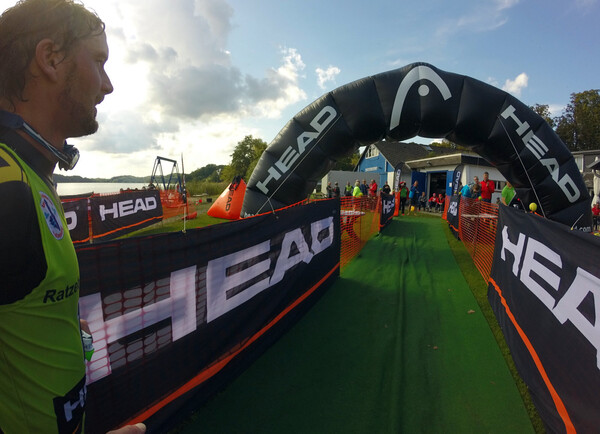
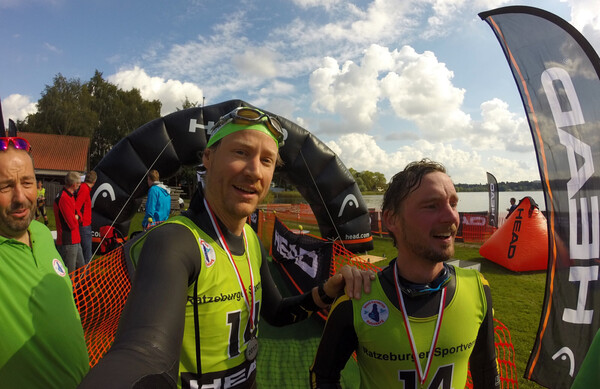
Reaching the finish line after 4:49:50 hours really was a great moment. Mischa was quite done, I felt I still had some power left, but was exhausted none the less. You don’t realize the hours passing by so fast, compared to other endurance events. This was really refreshing – in the truest sense of the word.

We came in 7th of just 11 all male teams. For a first try, I am happy about the result. There were three additional all female teams, and four mixed teams. So few people, right? If you count them all, we would’ve been 11th of 18 teams. That’s just 36 athletes!
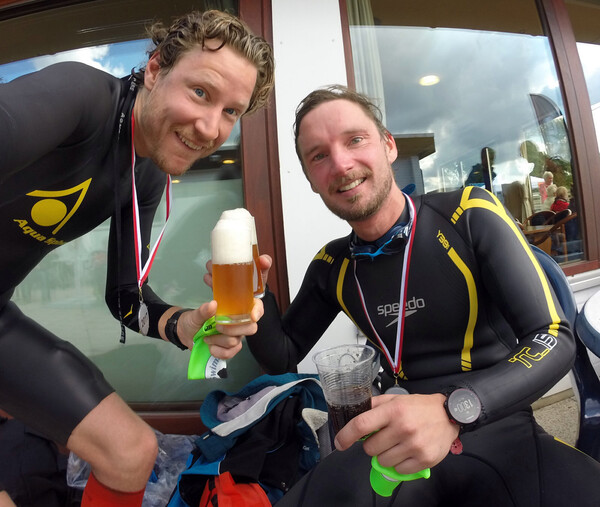
It’s been a very nice and well-organized event and I’m very happy that Mischa and I tried this. I can recommend it to everyone who can swim and run or as a goal for someone wants to learn both.
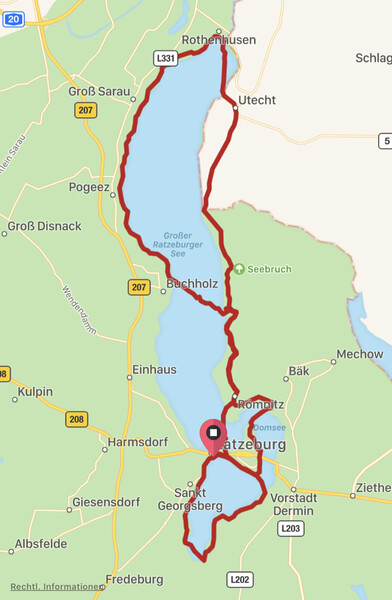
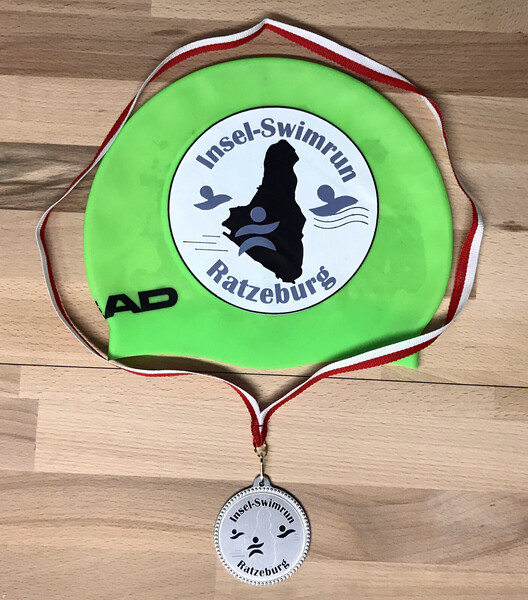
The Original Swimrun: ÖtillÖ
Could I put that experience to good use at the longer and more difficult ÖtillÖ 1000 Lakes? I certainly hoped so, because the Ratzeburg Swimrun was no walk in the park, either.
Two weeks left to go.
On the weekend in between both Swimruns I was signed up for a half marathon race in Hamburg which I had never done before. Those have become rare. This one was in the northern parts of our city, namely Alstertal. It’s a beautiful area, and the course was planned along the river Alster, through a forest, mainly on trails. Great training for the feet. Although it wasn’t an easy race with quite a few harsh uphill and downhill sections, I managed to finish it in a solid time of 1:43 hours.
The following week I got to train my cardio with my kids, because we all went to the beautiful city of Dresden to accompany my dear wife Sophie so she could be part of an international immunology congress. My three daughters and I spent all of the days outside and walked between 15,000 and 18,000 steps through Dresden each day. The kids are definitely keeping me fit!
Rheinsberg
After the congress was over, Sophie and the girls took a train back home while I took our car to go to Rheinsberg. Four hours later I found myself in said town on the border of German states Brandenburg and Mecklenburg-Vorpommern, in the center of the Mecklenburgische Seenplatte, an area with a huge amount of lakes.
I had never before been to this particular town, but I knew the area. It’s perfect for outdoor activities. Those Swedes made the correct decision to hold their German ÖtillÖ race right here. The town had a beautiful ancient castle and a little town square next to a similarly ancient church. That’s where Michael and Mats had put up a festival tent, and a few other sponsoring companies did so as well.
Rasmus arrived a few minutes later and we explored the expo.

Turns out we weren’t going to get our bib numbers and timing chips unless we showed them the mandatory gear:
- A first aid kit
- Two emergency whistles
- And, to our slight surprise, proof that we had valid ÖtillÖ insurance
Rasmus brought a special Swimrun first aid kit and we could buy the whistles right here at the expo, but we weren’t sure how to obtain that insurance. The staff had an idea, though. The ÖtillÖ company offered the correct insurance and we could buy it online on their website for 10 bucks. If if had been an Ironman-run event, I would assume it was another measure to milk the customers, but here I think it might have been a reasonable measure. This race is going to be far more dangerous than any other races I’ve done before.
Hats Off!
Along with the bib number vests, GPS tracking chips (real GPS chips with batteries!), and swim caps, our bag also contained two beanie hats. Those were special ones, made from organic and sustainably sourced cotton, and produced by poor but talented Sinti and Roma folks over in Romania for economically sustainable and ethically correct salaries. You’ve got to respect these Swedish people, they always seem to do the right thing.
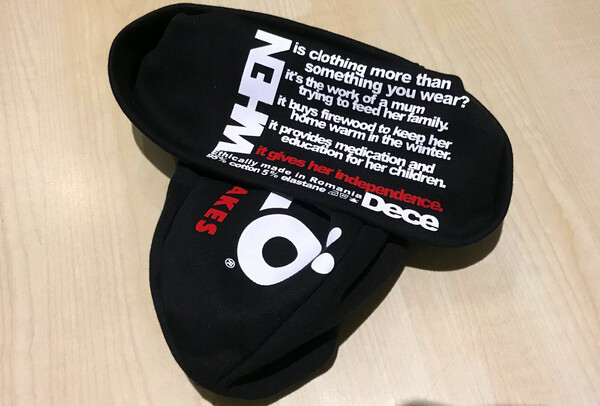
At 5:00 PM we were supposed to listen to the mandatory race briefing, held by the two founders themselves, Michael and Mats.
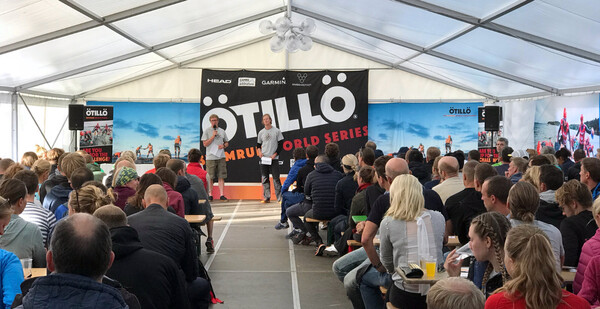
Fighting Sleep
Although both are very likable dudes and sure deserve admiration for successfully building this international Swimrun company from scratch, I had trouble staying awake during the monotonous hour-long talk by Michael. It’s one thing to be a good organizer and visionary, another to be a good public presenter.
One With Nature
He was basically going through all the mentioned rules and stressing the environmental aspects – littering of any kind equals instant disqualification – and reminding everyone to keep safe. His personal goal was to get every single team to the finish line. Good guy.
“You’ll either be too warm or too cold. That’s ÖtillÖ.” – Michael Lemmel
World Champions
He also mentioned some of the semi-pros who were present. And spoke about how this event was the grand finale of the ÖtillÖ World Series 2017.
It’s a bit confusing. ÖtillÖ has five events in Europe, as mentioned. Those are:
- 1000 Lakes – this one,
- Hvar on the Croatian islands in the Adriatic Mediterranean,
- Üto next to the Swedish birthplace of the ÖtillÖ Swimrun,
- Isles of Scilly – cold and windy, but mysterious and wonderful England, off the coast of Cornwall,
- Engadin – in the Swiss Alps
At every race of the five races you can collect points. Whichever team had the most points after this year’s last race, ÖtillÖ 1000 Lakes tomorrow, would be the big winner.
But just two weeks ago, the official World Championships on the islands in Stockholm’s vicinity took place, as well. You know, the 65k run / 10k swim race, which kicked the whole thing off back in 2002. That one apparently isn’t part of the World Series, so I guess there are two World Champion teams every year.
International Characters
This race’s status as the deciding race was the reason for many very fast teams from other countries to show up and try to win. 25 different nations were represented at a tiny race with just short of 300 participants in total. The biggest number of participants came from, you might have guessed, Sweden. Those guys love their Swimruns. But some Australians, Americans, and even Chinese and Kenyans were here, too.
Rasmus and I decided to have some food at a nearby restaurant, and call it a day quite early, in order to be relaxed tomorrow morning. He, like me, had a big enough car to sleep in, so we became camper van users for a night, here in the streets of Rheinsberg.
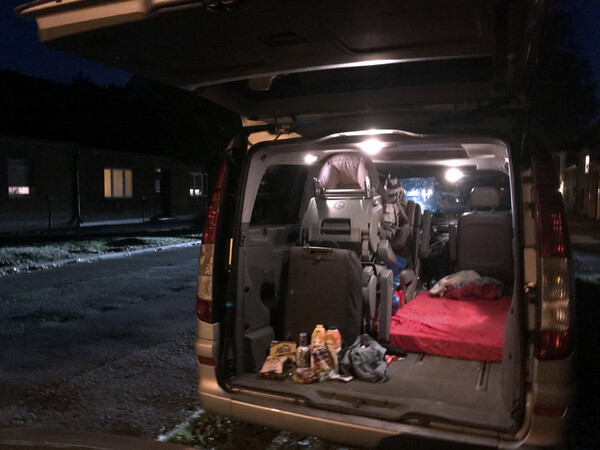
Day of the Race
The next morning started at 6 AM, it was still dark outside. Dark and cool, around 10 degrees centigrade. We stepped outside of the vans, had some muesli bars and bananas, and changed into our gear.
As it started raining, we wandered around town in search of the shuttle busses. As opposed to the Ratzeburg Swimrun, this one would really be a traditional A to B course, so we had to be driven somewhere else to kick it off. Some other athletes soon saw us and after a little misunderstanding we found the correct way. Three large busses carried us all over to the town of Wesenberg, roughly 45 minutes away from Rheinsberg.
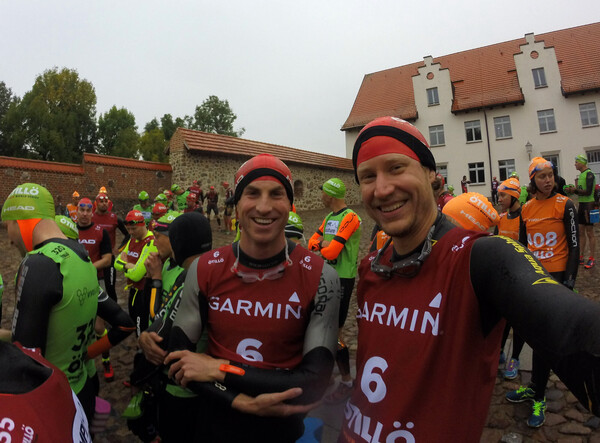
In the central area of the park, everything was setup already. A starting gate, a few porta potties, a bunch of locals in traditional clothing, and even a small coffee vendor who gave Rasmus and me a hot caffeinated beverage for free, after I talked to them. Another two bananas and a muesli bar, and I hoped I would be good to go.
When I asked Rasmus if another banana would be helpful or too much, he had the perfect phrase ready:
“Action beats inaction!”
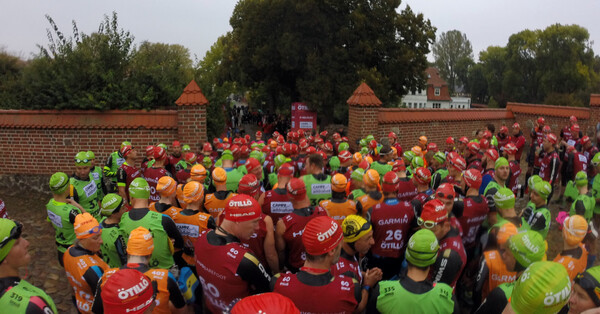
All 300 swim-capped and wetsuited athletes moved into the starting area, until all of a sudden without any kind of warning, a loud confetti cannon was fired off.
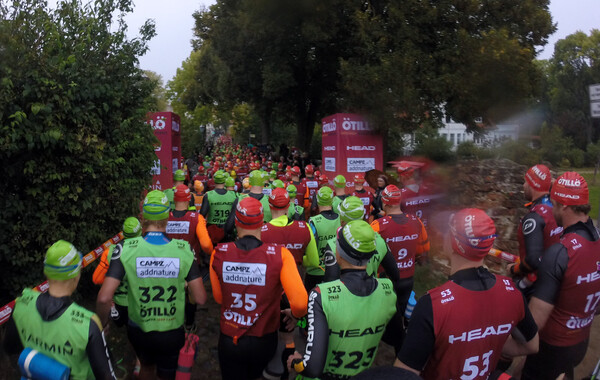
Start!
3.8 kilometers of running were supposed to warm us up in the 12 degree rain. That definitely worked, although the weather surely had some potential for improvement. The clapping citizens of Wesenberg were soon behind us and the trails began. 300 runners all in a line at a 5:00 min/km pace, going towards the first swim.
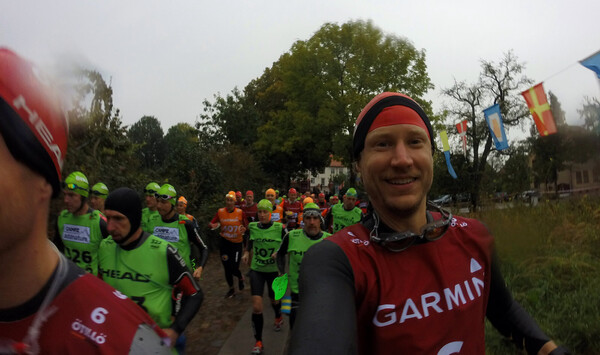
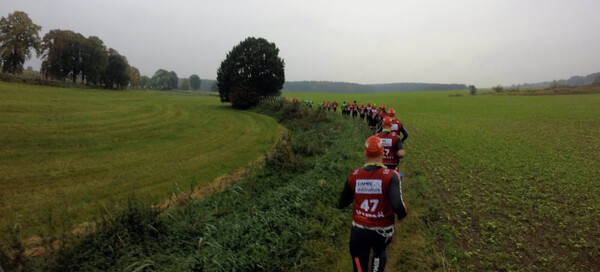
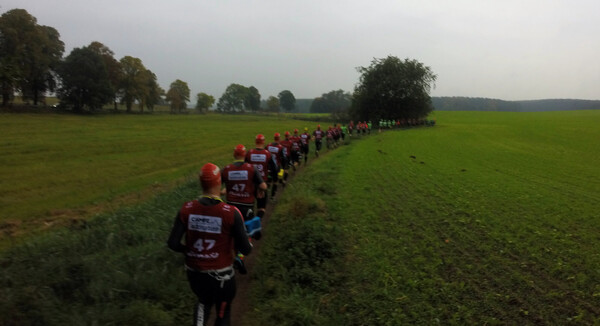
After around 20 minutes, there it was. A drone of the social media guys took some pictures as we stepped into the cold water – said to be hovering around 13 degrees.
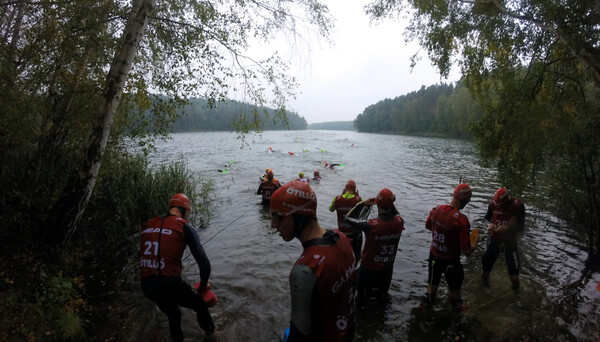
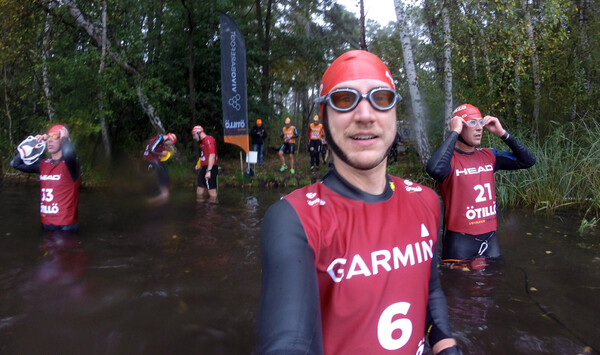
One kilometer of swimming was a long enough time to cool our cores down to probably quite unhealthy levels. Freezing, it was. When we stepped out on the other side, my fingers and feet were numb. Good thing there was another run coming up. 1.2 kilometers of running were barely enough to warm up, although it was uphill and downhill through very interesting terrain. 1,250 meters of swimming again. Shaking!
Still, we found a way to make it through. Right now, Rasmus and I realized that we wouldn’t be able to finish in a good time and position, by our standards. The field was very strong and our experience next to non-existent. Most teams were far ahead already, we only saw a few from time to time. They usually passed us by on the swims and we got them again on the runs.
You’re either too cold or too warm.
I was longing for the parts on which you were supposedly too warm, but they didn’t come. On the fifth segment, a 4.2k run, we finally got the chance to warm up. As the day progressed, the cold never really went away, but my fingers and feet weren’t numb again, so I would count that as a success.
One of the first few swim exits was note-worthy. It was on a private property, which the owner had surrendered for use.
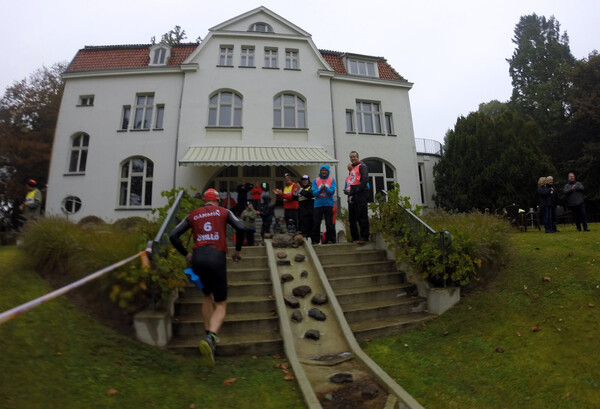
As we ran up the wet meadow towards his mansion, the grass got utterly destroyed. I hope he didn’t mind! An aid station on the property had some hot tea – that was just the best right now.
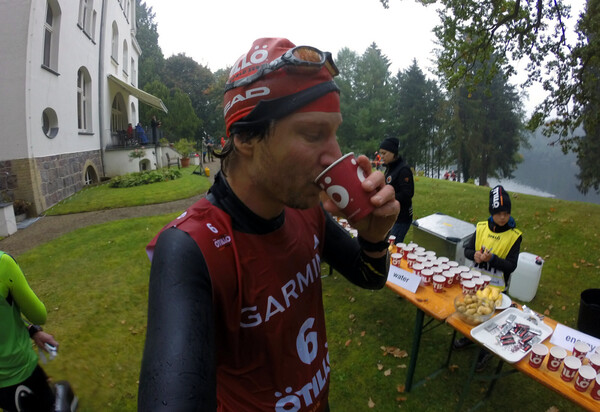
Another guy at an earlier aid station asked me how the water was like so far. I answered that it was cold but very clean. So clean I thought I could drink it. He mentioned this really is drinking water! They apparently use it. It’s that good.
Cut-Off
There were three so-called cut-off points. Those were defined places which you had to have reached by a certain time of day, or else you would be taken out of the race. Rasmus and I were comparably slow, but it wasn’t a danger to us. These points all had something in common:
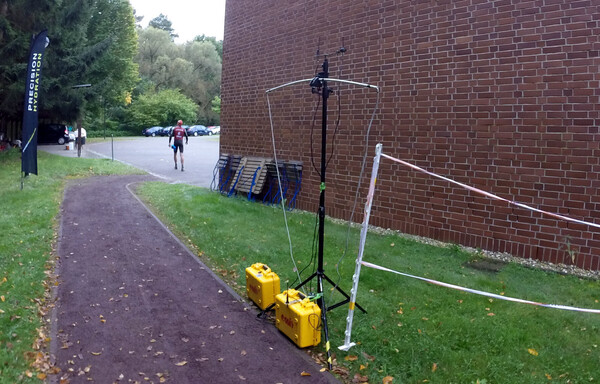
A post-apocalyptic looking GPS antenna data transmitter, and the presence of Michael himself. He really was part of the race – such a down to earth guy. Just two weeks ago he was with world renowned athlete Rich Roll, who raced in the World Championships and said on his Podcast that it was the hardest single day endurance event he had ever participated in. That’s quite something, coming from him.
Michael wished us well every time.
Volunteers
As always, it’s admirable that there are people offering their free-time in order to help us find the way or get some food or be safe during the swims. These ones were very nice as well, although rather small in number. The area is not very populated, and I guess many folks over here have other things to take care of. The information which the volunteers held, was sometimes not usable. There could have been better briefings.
Very few of the people who were standing at the swim entrances and exits knew how long the upcoming segment would be, or what the entrance would be like. This was crucial, because these places were so natural, you could rarely see the bottom of the lake. It could go down 10cm or a whole meter. One of those points was especially tricky, as we came through a dense forest towards the entrance. The helpful volunteer mentioned the steepness of the entrance, but didn’t tell us about a huge log near the bottom right after it. The result: large blue hematoma on both Rasmus’ and my shins.
On a positive note, when you acquire such an injury, you would usually go for something cool to stop the swelling – here, we didn’t have to do that, because we were already in very cold water as it is.
Other Challenges
Today’s race would take the winners about 4:30 hours, and the last team roughly 8:30 hours. All of them spend that whole time in a tight neoprene wetsuit. Of course, the human body has to do its deeds during that time.
We saw maybe half a dozen athletes who had to strip completely naked in the woods near to the course to avoid exploding. For us men, the cut-off wetsuit legs held a huge advantage.
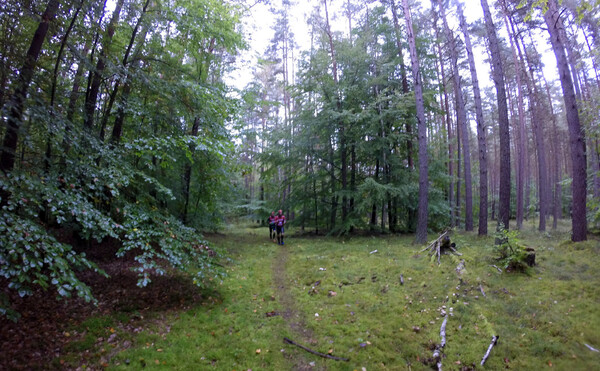
Time and Space
This type of event makes you lose track of the time. It’s the short segments, mainly. At one point Rasmus asked how long we were on the course, and estimated around 2:30 hours. My watch revealed 4:18 hours instead. Huge difference!
Sure, it got harder as the race progressed. In the second half I struggled with my focus a bit. Rasmus and I talked through most of the time, and that made us forget how time went by, but in some moments I sometimes felt I needed to focus to fight up a hill and couldn’t listen well or form good sentences myself, for that matter.
Food
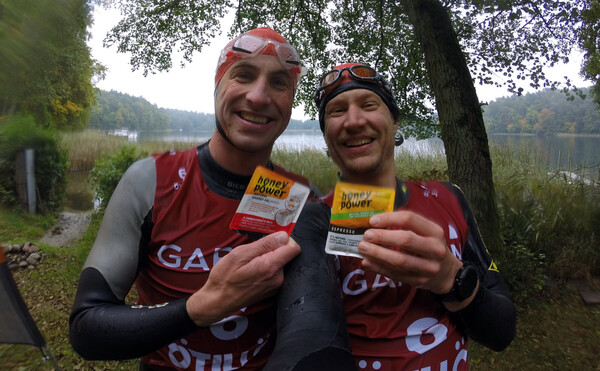
Surely, we both carried enough HoneyPower gels, and that got us through very well. A bit of solid food needed to be on the plate, as well, though. The aid stations had bananas and pretzels, which unfortunately both gave me short cramps on the runs. There were gummy-bears as well, and I must admit I was longing to have a hand full of them. But those are full of gelatin – made of pig’s connective tissue. Awful. I don’t support it and rather stay vegetarian.
The rain didn’t disappoint and got earth wet today. Surely, we were wet, anyways. Water coming from all sides almost all the time.
The Obelisk
Somehow, while talking and taking a right turn, we suddenly saw a site we knew, for the first time today.
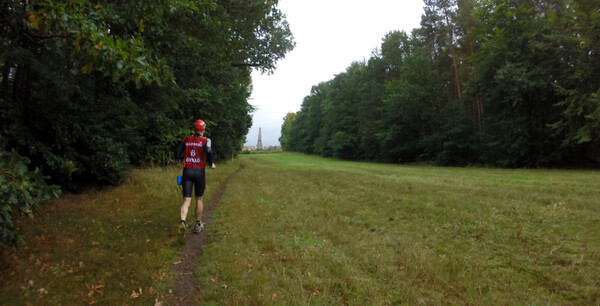
We’re almost done! Upon realization our faces lit up.
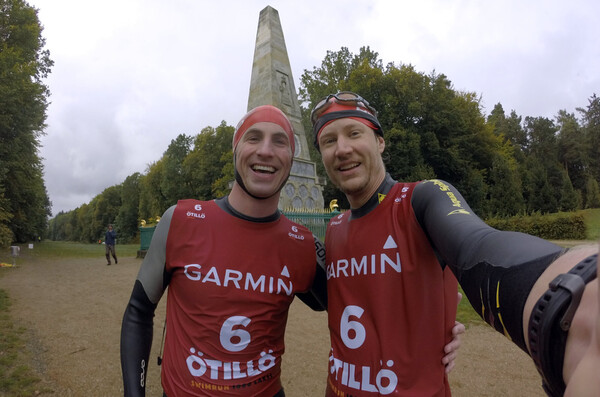
A drum group was here – how odd for a remote place like this. Still a welcome sight. Almost as welcome as the castle of Rheinsberg, which we could see from here, just straight across the lake.
Right then, the clouds moved away from the sun for the first time – blue sky! How very fitting. Great feeling.
A last 500 meter swim across the lake. As we climbed out of the water on the other side, there were actual crowds present! Also very unusual. We were laughing and took a picture of ourselves first.
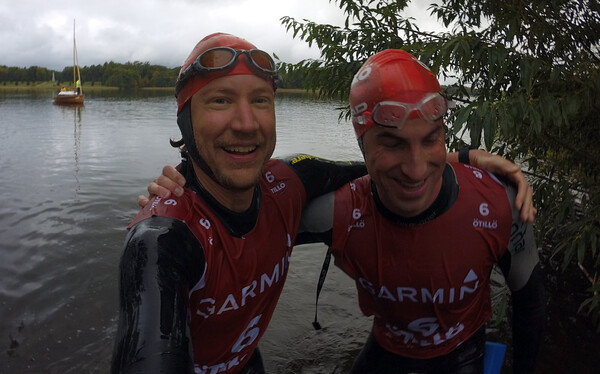
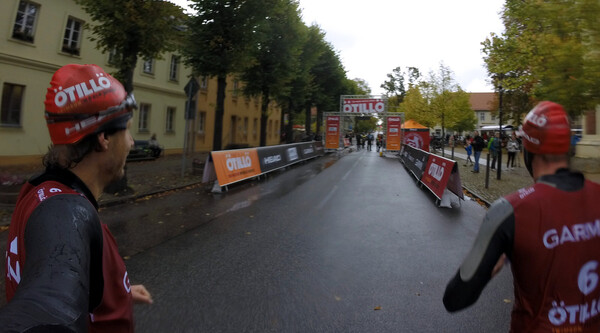
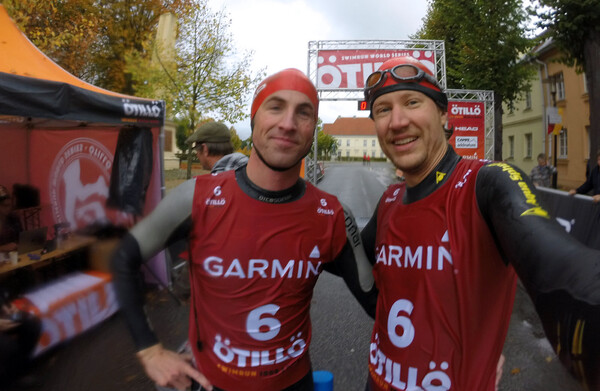
7:18 hours. A long time. A good time. A time for a hug!
The other founder, Mats, was waiting at the finish line for everyone and gave us a hug as well. What a nice event, I must say. I doesn’t matter at all that we came in as the 103rd team of 110 in total. As I’ve mentioned, this wasn’t a tourist event, but the real deal, full with semi-pros trying to score real points. Still, every single one can be proud of having finished this race.
Take a look at what we’ve done today:
- 🏃 3,800m
- 🏊 1,000m
- 🏃 1,200m
- 🏊 1,250m
- 🏃 4,200m
- 🏊 430m
- 🏃 2,200m
- 🏊 1,300m
- 🏃 7,100m
- 🏊 650m
- 🏃 4,100m
- 🏊 550m
- 🏃 3.200m
- 🏊 270m
- 🏃 2,000m
- 🏊 1,100m
- 🏃 1,900m
- 🏊 510m
- 🏃 3,800m
- 🏊 500m
- 🏃 300m
Total distances:
- 🏃 33,800m
- 🏊 7,560m
- 🏊🏃 41,360m
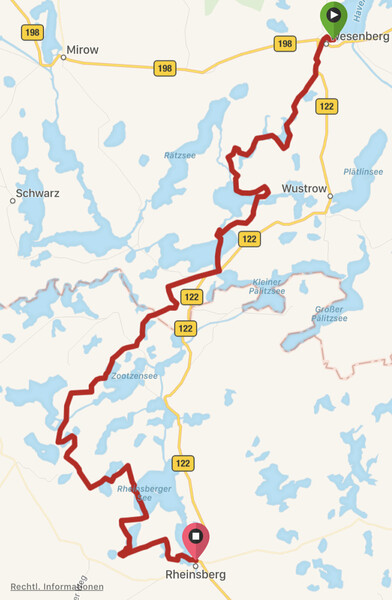
Quite an effort, and I’m glad we did it. Next time we’ll probably choose the warmer ÖtillÖ Hvar in Croatia as our race, though!
Swimruns are definitely something to check out if you’re into swimming and running. Fun and tough athletic adventures.
Thanks for reading!
How do you feel after reading this?
This helps me assess the quality of my writing and improve it.
Leave a Comment